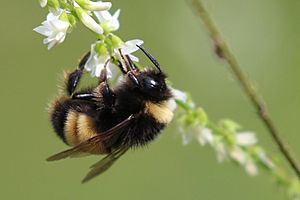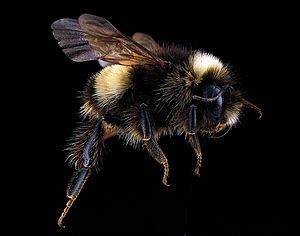Yellow-banded bumblebee facts for kids
The yellow-banded bumblebee, Bombus terricola, is a type of bumblebee found in southern Canada and the eastern and central United States. These bees have amazing skills, like being able to adapt if their queen is gone, picking the best flowers to visit, and even controlling their body temperature to fly in cold weather! Once very common, their numbers have dropped since the late 1990s. This is likely due to cities growing and tiny parasites making them sick. Yellow-banded bumblebees are super important for pollinating wild flowers and crops like alfalfa, potatoes, raspberries, and cranberries.
Quick facts for kids Yellow-banded bumblebee |
|
|---|---|
 |
|
| Conservation status | |
| Scientific classification | |
| Genus: |
Bombus
|
| Species: |
terricola
|
Contents
What Kind of Bee Is It?
The yellow-banded bumblebee, B. terricola, belongs to a group of insects called Hymenoptera. This group includes ants, bees, wasps, and sawflies. It is part of the Apidae family, which has bumblebees and honey bees. Within this family, it's in the Bombus group, which is all about bumblebees. A scientist named Kirby first described this species in 1837.
Some people once thought the Western bumblebee (Bombus occidentalis) was just a type of B. terricola. But now, most experts agree they are different species. B. terricola is also very similar to another bee called B. affinis. They are so alike that B. affinis bees can sometimes take over B. terricola nests without the original bees even knowing!
What Does It Look Like?
The yellow-banded bumblebee is mostly black and yellowish-tan. It has a special fringe of short, yellow-brown hairs on its fifth body section (called the abdomen).
The queen bee is about 18 mm long. The front part of her body (thorax) is yellowish-brown. Parts of her abdomen (sections 2, 3, 4, and the sides of section 6) are also yellowish-brown. The rest of her body is black.
Worker bees look like the queen but are smaller, measuring about 9 to 14 mm long. Male bees are in between, about 13 to 17 mm long. In males, abdominal sections 2, 3, and 7 are yellowish-brown. The sides of abdominal section 6 are usually yellowish-brown too.
Where Do They Live?
Bombus terricola bees live in the eastern and central parts of the United States. They also live in southern Canada. You can find them in many different places. These include cities, open fields, grasslands, wet areas, forests, and farms. They can live in high mountain meadows or even warmer lowland forests.
Life Cycle of a Colony
A yellow-banded bumblebee colony grows in three main stages.
Starting a Colony
The first stage is when a single queen bee starts her colony. She lays her first eggs, which hatch into worker bees. These workers help the colony grow. The queen keeps laying more eggs to make more workers.
Making Males
The second stage is when the queen changes what kind of eggs she lays. She stops laying eggs that become workers and starts laying eggs that will become male bees.
Colony Competition
In the third stage, the worker bees start to act aggressively towards each other and even towards the queen. They might even eat each other's eggs during this time.
When There's No Queen
Sometimes, a B. terricola colony loses its queen, or the queen becomes too weak. If the queen can't lay eggs well, or at all, the worker bees start laying their own eggs. These worker-laid eggs usually become male bees. This happens more often in smaller colonies. When there's no strong queen, these male-heavy colonies try to find a new, young queen. This helps the colony survive and thrive.
How They Find Food
Yellow-banded bumblebees gather in areas where there is a lot of nectar. They are smart! They can tell which flowers other bees have already visited. They also know which flowers don't have much nectar or pollen left. They usually visit flowers in a straight line and don't go back to flowers they've already visited.
These bees tend to go to places rich in food. Once they've used up the resources there, they usually don't go back. Instead, B. terricola will fly to new places to find more food. Even though flying uses energy, they do it to find better food sources later. We don't fully understand how they find new food. We also don't know if they remember specific flowers or if they remember landmarks like a nearby tree.
Pollinating Flowers
B. terricola bees are very picky about the flowers they pollinate. They can visit about 12 to 21 flowers every minute! They decide which flowers to visit based on how much nectar and pollen they have. They can even tell the quality of pollen from a distance, but how they do this is still a mystery.
Each bee flies a bit differently. Some fly fast, some slow. Some hover over flowers but never land. How many flowers they visit depends on how many good flowers they found on their last flights. Good flowers are ones with lots of pollen or nectar. One study found that B. terricola bees skip flowers they've already visited, especially if those flowers didn't have much pollen. When they release pollen, they make one to four short buzzing sounds, each lasting about a second. While buzzing, they also spin around clockwise or counterclockwise.
Types of Flowers They Visit
B. terricola bees are known to visit milkweed (Aslepia syriaca), jewelweed (Impatiens biflora), and fireweed (Epilobium angustifolium). They tend to visit the same flowers over and over, especially if those flowers gave them a lot of nectar and pollen in the past.
Temperature Control
Bumblebees can fly in many different temperatures, even when it's freezing! But they need their body temperature to be at least 29-30 degrees Celsius before they can fly freely. Like honeybees, they warm up their bodies before taking off. To raise their body temperature, especially in their chest area, these bees use a lot of energy.
These bees can visit many spread-out flowers quickly, whether the air is hot or cold. Sometimes, when it's cold, they don't have enough heat to keep flying all the time. So, landing on flowers helps them warm up. This keeps their chest temperature high enough to fly. Since they use so much energy to control their temperature, they drink a lot of nectar from the easiest-to-reach flowers. This nectar gives them the energy they need. By keeping their body temperature high, B. terricola can look for new food sources and quickly fly away if a predator is nearby.
Other Animals and Bees
Parasites
Some tiny creatures called parasites can harm yellow-banded bumblebee populations. For example, a larva called Physocephala infects about 12% of worker B. terricola bees in Ontario, Canada, during July and August.
Another parasite that affects these bees is a tiny, single-celled fungus called Nosema bombi. This fungus is known to infect bumblebees and might be one reason why Bombus terricola numbers are going down. This parasite is found a lot in Bombus terricola populations.
Why Are Their Numbers Dropping?
Like many other bumblebee species, the numbers of B. terricola have been falling. A study in Illinois showed a big drop in their numbers between 1940 and 1960. In Illinois, a lot of farming and city growth have taken away the natural places where these bees used to live. This decline in B. terricola happened at the same time as a huge increase in farms and cities. Also, the Nosema bombi parasite might be making their numbers drop even more, as it especially attacks these bees.
Conservation Status
Many bumblebee species in North America have seen their numbers drop sharply since the mid-1990s, and the yellow-banded bumblebee is one of them. The Xerces Society for Insect Conservation has put Bombus terricola on their "Red List" of bees that are in danger.
The yellow-banded bumblebee has disappeared from many parts of where it used to live. However, it is still found in Vermont, New Hampshire, and Maine, where its population seems to be stable. It also seems to be growing in the Great Smoky Mountains. It's not clear if this is because these bees have become stronger against the Nosema bombi parasite, or if the parasite just hasn't spread to these areas yet. Another bee, the rusty-patched bumblebee, has had an even bigger drop in its numbers. Only time will tell if these bees will survive or if they will disappear completely.
Images for kids




